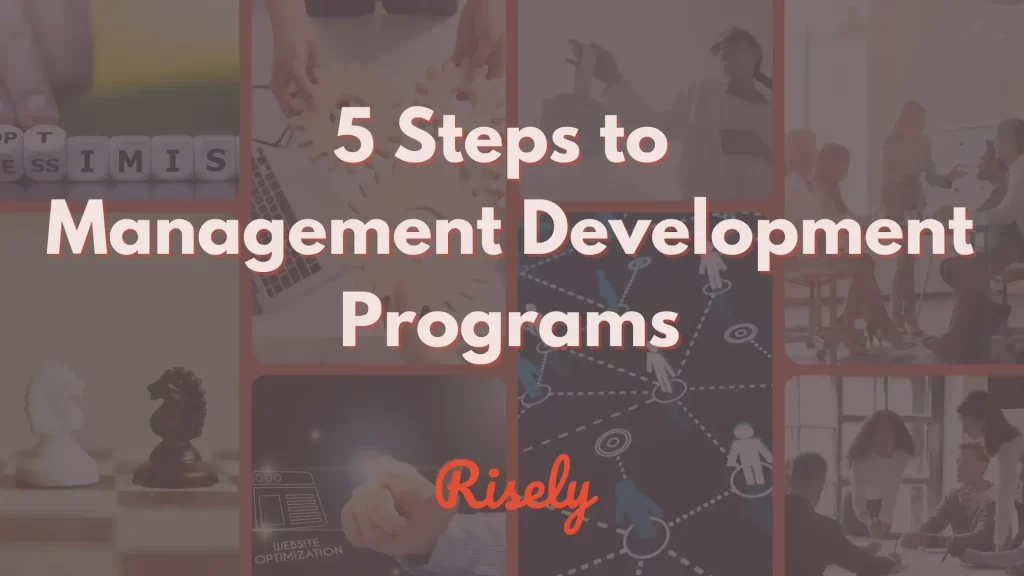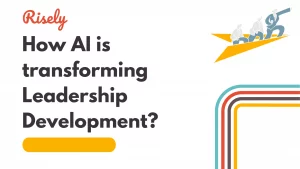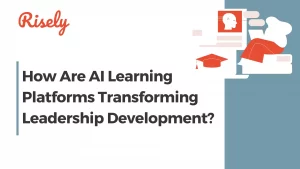As teams expand, the need for effective leadership becomes more significant. That’s where management development programs (MDPs) come into play. These programs equip your team leaders with the necessary skills and knowledge to drive business growth and improve employee engagement.
In this blog, we will cover everything you need to know about MDPs, including successful examples of how they have been implemented in other companies, why investing in them is crucial for your organization, critical components of an effective MDP, and how to implement one successfully. With the right tools and strategies in place, you can create a solid management development program that sets your team up for long-term success. So let’s get started.
What is a Management Development Program?
A management development program is structured activities and training designed to help employees develop the knowledge, skills, and abilities needed to become effective managers. It involves training, coaching, mentoring, and job shadowing. A management development program aims to prepare employees for leadership roles within an organization by providing them with the tools they need to manage people, projects, and resources effectively. Some common topics in management development programs include communication skills, decision-making, strategic planning, team building, and performance management. Check out: Becoming The Best Manager: Why AI Co-Pilot Overtakes Manual Solutions?Why Does Management Development Matter?
Management development is essential to teams because it helps build the skills and capabilities of managers, which in turn can lead to more effective leadership and better outcomes for the team. When employees have access to training and development opportunities, they are better equipped to handle the challenges in their roles, such as managing conflicts, delegating tasks, setting goals and expectations, and communicating effectively – all of which can be the stepping stones to a managerial role. It helps create a more positive and productive work environment where team members feel supported and motivated to do their best work. In addition, investing in management development can help organizations attract and retain top talent by demonstrating a commitment to employee growth and development.Examples of Successful Management Development Programs
Effective management development programs manifest in diverse ways. For example, the personalized development plans offered by Procter & Gamble’s “Leadership Academy” allow for growth in leadership capabilities. General Electric’s “Crotonville Leadership Development Program” provides hands-on experience through case studies and simulations. Peer-to-peer learning is facilitated by Google’s “Googler to Googler” program, while Deloitte’s “NextGen Leaders” helps mid-level managers with coaching and mentoring for leadership positions. The common factor within these management development programs lies in enhancing and developing the in-house and managerial capacity to ensure better outcomes and improvements in the bottom line for the team.Other Interesting Reads
Why Invest in Management Development Programs?
Investing in management development programs can significantly benefit a team by improving employee performance and productivity. LinkedIn Workplace Learning report highlights management development programs as among the top priorities of learning and development managers. These programs help employees develop leadership skills, leading to better decision-making and problem-solving abilities. It is the key to enhancing internal mobility and building long-lasting professional relationships. Additionally, MDPs foster employee retention and boost morale by committing to their development. Without effective management development programs, teams are more likely to face succession challenges and regular talent crunch, which impede continuous growth. A few long-term benefits of management development programs include:Increase employee engagement and productivity
Investing in management development programs is an effective way to increase employee engagement and productivity. These programs are a great way to start a team growth and development dialogue. In addition, leadership training through management development programs enhances management skills, leading to effective decision-making and problem-solving. Improved communication and collaboration within teams across workforce modules is another outcome of MDPs. Enrolling mid-level managers with potential leadership capabilities in MDPs can help them develop critical skills needed for management positions. Moreover, teams can demonstrate their commitment to inclusion, career development, and performance management of their employees by taking up such initiatives and thus push up employee engagement levels massively.Improve retention rates
Effective employee retention is vital, and investing in Management Development Programs is an excellent way of achieving this objective. By identifying potential leaders within the team, MDPs provide employees with learning journeys that enable them to improve management skills like communication and soft skills like leadership capabilities. This approach increases workforce inclusion and provides mid-level managers with critical skills to manage diverse teams successfully. It ensures continuity as well as growth for top talent within the team – leading them to envisage secure careers with the team.Key Components of Effective MDPs
Creating an effective Management Development Program requires adhering to a few key components. One crucial element is ensuring that the MDP aligns with your team’s overall strategy. Additionally, identifying which team members will benefit most from this development program is critical in customizing its content to their unique requirements. Finally, incorporating interactive learning techniques such as hands-on activities, case studies, and group projects can significantly enhance leadership skills and problem-solving abilities while preparing potential leaders for management positions. Hence, a quality management development program should ideally cover the following areas:- The team’s mission and vision, highlighting their personal values and professional goals
- Emphasis on the core competencies of the manager, roles and responsibilities they would undertake, and the tools required to accomplish them
- Critical leadership and management skills
5 Steps to Creating a Successful Management Development Program
The art of crafting a solid management development program can vary a lot depending on the context of your organization. While keeping your team’s and team member’s needs in mind, here are the steps you should take to build a good management development program. Remember that you can always tweak things to better fit your needs and seek alternatives based on the participant’s feedback.Identify the development needs and goals of your team
Management development programs are most effective when they provide targeted groups of employees with opportunities to build various critical skills. First, define clear goals and objectives to achieve with the MDP. Then, identify employees who will participate in the program and assess their current management skills and expertise level. These programs should have clear goals aligned with the team’s strategy and be interactive for better results. A focus on leadership training is essential as it helps develop communication skills and decision-making abilities while simultaneously fostering emotional intelligence. Hence, managers should understand their team’s present and potential needs to craft a plan accordingly instead of adopting generic strategies that are likely misfits.Finding resources to get your team going
Once you know the destination, it’s time to design the way. At the same time, many typical options are available in the market, and it is essential to pick the one that works for your team. Or create one that is as unique as you! The key is to remember that your management development program should lend you a helping hand in the learning and development journey through features such as:- Personalized learning journeys for different people
- Assessment and feedback mechanisms
- The ability to track results and monitor performance
- Ensuring that learning sticks with you
Building enthusiasm and securing participation
Effective management development programs strive towards building a positive team culture that nurtures potential leaders at all levels. Hence, learning and development managers should create the atmosphere required to facilitate such learning by developing an open and curious work culture. The key lies in embedding a growth mindset and continuous learning within the team culture. A growth mindset culture enables teams to always look for opportunities and plan their development no matter how much the world changes. Such teams look at failures as learning outcomes and are not afraid of trying their hands at new skills. Similarly, a culture of continuous learning, designed to facilitate learning for all on the board with the ultimate aim of progression, ensures that learning initiatives have earned the requisite temperament and attitude for their success.Collecting feedback and adapting
Providing regular feedback is essential in any management development program. It helps team members gain insights into their strengths while understanding the areas where they need improvement. Clear expectations, progress tracking, coaching, and support are critical to effective performance management. On the other hand, the leaders of such programs, typically the learning and development managers, should also gather feedback from the course takers to understand their perspectives. It would help create interventions to make the program more intuitive and personalized for your unique set of learners and their needs. Proper evaluation of program effectiveness allows for improvement while gathering participant feedback helps tailor content to meet individual needs.Reinforcing the learning outcomes
Once the training is over, where does the learning go? The key to effective management development lies in retaining and applying the skills learned so far. Hence, it is essential to create opportunities for managers to use their new skills. Managers can do this by enriching existing job roles with more exciting duties or making specific spaces, such as short-term projects, for hands-on work. In addition, positive behavior reinforcement through praising good work, offering constructive criticism, and offering growth opportunities can enhance the performance of mid-level managers who are potential leaders in management positions. How to reinforce learning at work? Find out here: Using Training Reinforcement to Create Impact: Top 5 Secrets for L&D ManagersSuccession planning and career development
Effective Management Development Programs involve strategic succession planning and career development initiatives that offer employees opportunities for professional growth. These programs identify critical positions within the organization and prepare potential leaders to take over these roles through training and mentorship modules that enhance their leadership capabilities and necessary skills. Successful MDPs offered by major corporations such as IBM, GE, and Procter & Gamble prioritize inclusion in their workforce by providing manager training that focuses on soft skills such as communication, effective performance management systems providing regular feedback to improve employee performance. Such management development programs, when executed right, can become a tactical part of your team’s succession planning strategy too.What are the Common Challenges in Creating Effective Management Development Programs?
Some common challenges that managers may face when implementing management development programs include the following:- Resistance to change: Managers may encounter resistance from team members who are comfortable with the status quo and may not see the value in participating in a development program. Moreover, some candidates may hesitate while transitioning from being a team member to a manager.
- Limited resources: Budget constraints, time constraints, and limited staffing can make implementing a comprehensive management development program difficult.
- Lack of buy-in from senior leadership: Without support from senior leaders, it may be difficult to gain traction for a management development program and get employees engaged. Learn more about securing buy-in for training to make your initiatives successful.
- Difficulty measuring results: Measuring the effectiveness of a management development program can be challenging, particularly if there is not a clear set of metrics or KPIs in place to track progress.
- Inadequate training materials: If the training materials are not well-designed or do not address the needs of the participants, it may be difficult to engage employees and achieve desired outcomes.
Conclusion
A solid management development program is the key to unlocking your employees’ potential and building a successful business. Investing in MDPs increases employee engagement and productivity while improving retention rates. To create an effective MDP, focus on leadership training and development, performance management and feedback, succession planning, and career development. Remember to tailor your program to your organization’s specific needs and goals. If you’re looking for inspiration, check out our examples of successful MDPs. Ready to take the next step? Sign up for Risely today.Ensure consistent constructive feedback to improve your team’s development programs.
Take the free constructive feedback assessment now to learn more and avoid mistakes.
What is a management development program?
A management development program is a structured and systematic approach to enhance the knowledge, skills, and capabilities of individuals in leadership positions. It aims to groom managers and prepare them for higher-level responsibilities within an organization.
What is the main focus of management development program?
The main focus of a management development program is to develop and strengthen managerial competencies. These include skills such as strategic thinking, decision-making, problem-solving, communication, teamwork, and leadership. The program aims to equip managers with the necessary tools to effectively lead teams and drive organizational success.
What are the contents of management development program?
The contents of a management development program typically cover a range of topics relevant to managerial roles. This may include leadership theories and styles, organizational behavior, performance management, conflict resolution, project management, financial acumen, and change management. The program is designed to provide a comprehensive understanding of the various aspects of management.
What are the benefits of MDP?
There are several benefits of participating in a management development program. It helps managers acquire new skills and knowledge, enabling them to perform their roles more effectively. The program fosters personal and professional growth, enhances leadership abilities, and improves decision-making capabilities. It also increases employee engagement, retention, and overall organizational performance.






